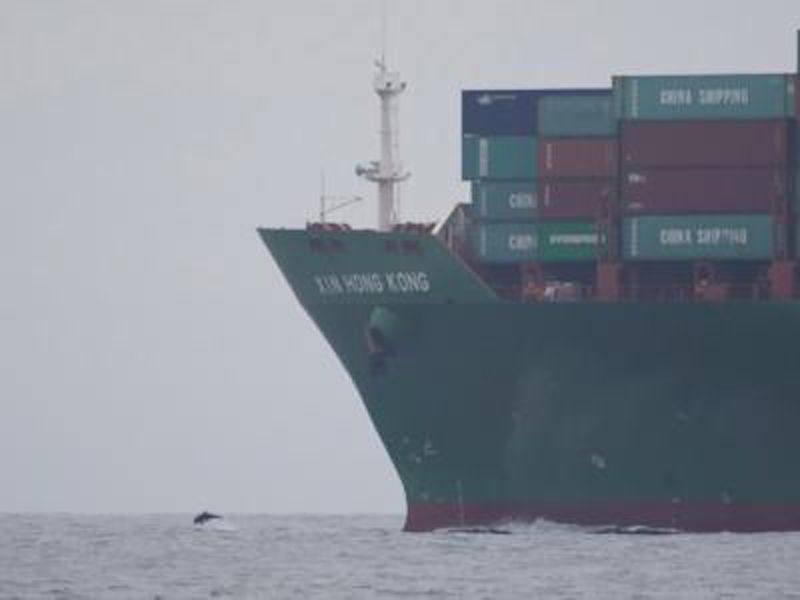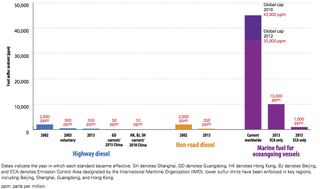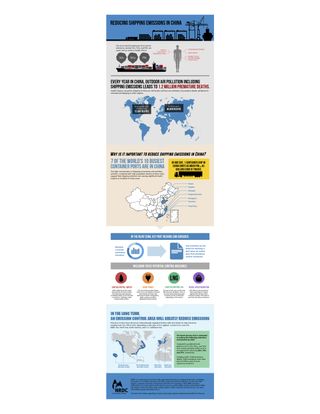China Won't Breathe Easy Until Port Pollution Solved (Op-Ed)

Barbara Finamore is Asia director for the Natural Resources Defense Council (NRDC). Finamore contributed this article to Live Science's Expert Voices: Op-Ed & Insights.
As President Barack Obama and Asia-Pacific leaders gather in Beijing for the upcoming Asia-Pacific Economic Cooperation (APEC) summit, climate change and air pollution will undoubtedly be on the agenda. This summit provides an important opportunity for these leaders to address one of the most significant, and largely unregulated, sources of toxic air pollutants and black-carbon emissions in Asia: ports and shipping systems.
Nine of the 10 busiest and most densely populated container ports in the world are in Asia, seven of them in China. As detailed in NRDC's new report, "The Prevention and Control of Shipping and Port Air Emissions in China," container ships loading their cargo in China and elsewhere in Asia are free to run on dirty bunker fuel, a waste product of traditional fuel-oil processing. Bunker fuel contains a number of pollutants — such as diesel particulate matter, oxides of nitrogen (NOx) and oxides of sulfur (SO2) — that are known to cause cancer, respiratory illness and premature death, as well as exacerbate climate change and damage the oceans.
For example, the sulfur levels in marine bunker fuel are 100 to 3,500 times higher than those permitted in on-road diesel fuel in China. As a result, in a single day, one container ship cruising along the coast of China emits as much diesel pollution as 500,000 new Chinese trucks.
Making the fuel switch
Yet thanks to increasingly stringent regulations outside of Asia, those same oceangoing vessels must switch to low-sulfur fuel before they reach the other end of their journey, when they reach North America, the U.S. Caribbean Sea, the North Sea and the Baltic Sea.
Starting in January 2015, the fuel-sulfur limit in these four regions (known as Emission Control Areas, or ECAs) will be lowered from 10,000 parts per million (ppm) to 1,000 ppm (basically, from 1 percent to 0.1 percent). Starting in 2016, new vessels traveling to any port in North America or the U.S. Caribbean will also be required to reduce by 75 percent their NOx emissions, another greenhouse gas that contributes to global warming and boosts levels of regional ozone and fine particulate pollution. As detailed in our report, these new pollution standards are driving the development of 21st-century ports and shipping emission-control systems, including alternative fuels and advanced emission-control technologies on ships.
Sign up for the Live Science daily newsletter now
Get the world’s most fascinating discoveries delivered straight to your inbox.

In China, joint regional and national efforts to control shipping emissions, such as establishing an ECA for major Chinese port regions or for the entire country, should be seriously considered as a way to address concerns over port competitiveness and achieve the greatest environmental and health benefits in China.
The impact of plummeting pollution
Controlling shipping pollution offers enormous, and cost-effective, public health and environmental benefits. According to a U.S. Environmental Protection Agency (EPA) analysis, the public health benefits in North America alone are expected to be more than 10 times the compliance costs. Since China's port cities are among the most densely populated and busiest in the world, the benefits there would likely be even greater.
Yet, rather than clean up their pollution for their entire journey, these vessels currently switch back to dirty bunker fuel before they return to China. Controlling emissions from ports and shipping would give China's war on pollution a much-needed boost. Some ports have begun to take initial measures. Hong Kong, for example, is the first to strictly enforce the use of low-sulfur fuel (500 ppm, or 0.05 percent sulfur content) by local vessels and plans to be the first in China to mandate ocean-going vessels use low-sulfur marine diesel. Shenzhen has followed Hong Kong, announcing a comprehensive list of measures for cleaning up ships, trucks and port equipment, including offering subsidies to encourage fuel switching and the use of shore power. Other port cities and regions like Shanghai, Qingdao and the provinces of Guangdong, Jiangsu and Shandong have also issued plans to promote shore power, electrification of port equipment, and trucks powered by electricity and natural gas.

Taking the next steps
Although those initial steps are encouraging, the measures adopted for the control of air emissions from shipping and ports, as well as related research, are still at an early stage in China. More work needs to be done to ensure that solid, port-specific analysis and detailed implementation measures back those plans. This is necessary in order to ensure cost-effectiveness, enlist the support of all stakeholders, and avoid merely shifting ships and their pollution to other, less-regulated ports.
NRDC has worked for over two decades to eliminate dirty diesel fuel and to clean port operations worldwide, including pioneering action plans to clean up the largest toxic hotspots, implement clean freight, and reduce port-related pollution in the United States and elsewhere. NRDC was also the only non-governmental organization invited to join the U.S. government delegation to the International Maritime Organization to create a North American Emission Control Area. We hope the information in our new report will help support the development of clean shipping and port initiatives in China.
Unlike the factory closures and other temporary measures Beijing is planning for the APEC summit, tackling pollution from shipping and ports in China can help clear the air and protect the planet long after these world leaders return home.
Follow all of the Expert Voices issues and debates — and become part of the discussion — on Facebook, Twitter and Google+. The views expressed are those of the author and do not necessarily reflect the views of the publisher. This version of the article was originally published on LiveScience.com.











